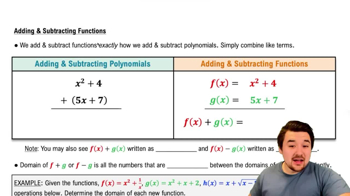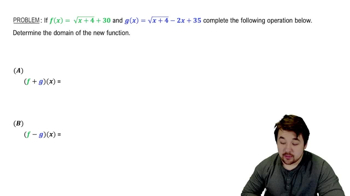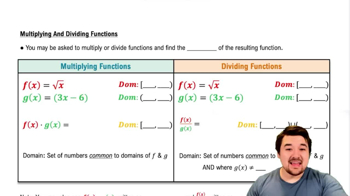Table of contents
- 0. Functions7h 52m
- Introduction to Functions16m
- Piecewise Functions10m
- Properties of Functions9m
- Common Functions1h 8m
- Transformations5m
- Combining Functions27m
- Exponent rules32m
- Exponential Functions28m
- Logarithmic Functions24m
- Properties of Logarithms34m
- Exponential & Logarithmic Equations35m
- Introduction to Trigonometric Functions38m
- Graphs of Trigonometric Functions44m
- Trigonometric Identities47m
- Inverse Trigonometric Functions48m
- 1. Limits and Continuity2h 2m
- 2. Intro to Derivatives1h 33m
- 3. Techniques of Differentiation3h 18m
- 4. Applications of Derivatives2h 38m
- 5. Graphical Applications of Derivatives6h 2m
- 6. Derivatives of Inverse, Exponential, & Logarithmic Functions2h 37m
- 7. Antiderivatives & Indefinite Integrals1h 26m
- 8. Definite Integrals4h 44m
- 9. Graphical Applications of Integrals2h 27m
- 10. Physics Applications of Integrals 2h 22m
0. Functions
Combining Functions
Problem 62
Textbook Question
Simplify the difference quotient ƒ(x+h)-ƒ(x)/h
ƒ(x) = 10
 Verified step by step guidance
Verified step by step guidance1
Step 1: Understand the function given, \( f(x) = 10 \). This is a constant function, meaning it does not change with different values of \( x \).
Step 2: Substitute \( f(x) \) and \( f(x+h) \) into the difference quotient formula. Since \( f(x) = 10 \), we have \( f(x+h) = 10 \) as well.
Step 3: Write the difference quotient: \( \frac{f(x+h) - f(x)}{h} = \frac{10 - 10}{h} \).
Step 4: Simplify the expression: \( \frac{10 - 10}{h} = \frac{0}{h} \).
Step 5: Recognize that \( \frac{0}{h} = 0 \) for any non-zero \( h \). Therefore, the simplified difference quotient is 0.
 Verified video answer for a similar problem:
Verified video answer for a similar problem:This video solution was recommended by our tutors as helpful for the problem above
Video duration:
2mPlay a video:
Was this helpful?
Key Concepts
Here are the essential concepts you must grasp in order to answer the question correctly.
Difference Quotient
The difference quotient is a formula used to calculate the average rate of change of a function over an interval. It is expressed as (ƒ(x+h) - ƒ(x)) / h, where h represents a small change in x. This concept is fundamental in calculus as it leads to the definition of the derivative, which measures the instantaneous rate of change.
Recommended video:
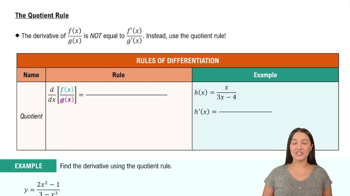
The Quotient Rule
Function Evaluation
Function evaluation involves substituting a specific value into a function to determine its output. In this case, with ƒ(x) = 10, the function returns a constant value regardless of the input x. Understanding how to evaluate functions is crucial for simplifying expressions like the difference quotient.
Recommended video:
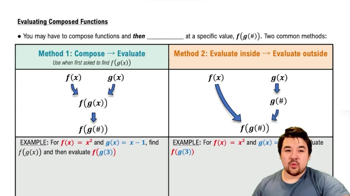
Evaluating Composed Functions
Limit Concept
The limit concept is central to calculus, particularly in defining derivatives. As h approaches zero in the difference quotient, the expression converges to the derivative of the function at a point. This concept helps in understanding how functions behave as inputs change infinitesimally, which is essential for analyzing continuity and differentiability.
Recommended video:

One-Sided Limits

 5:56m
5:56mWatch next
Master Adding & Subtracting Functions with a bite sized video explanation from Nick
Start learning
